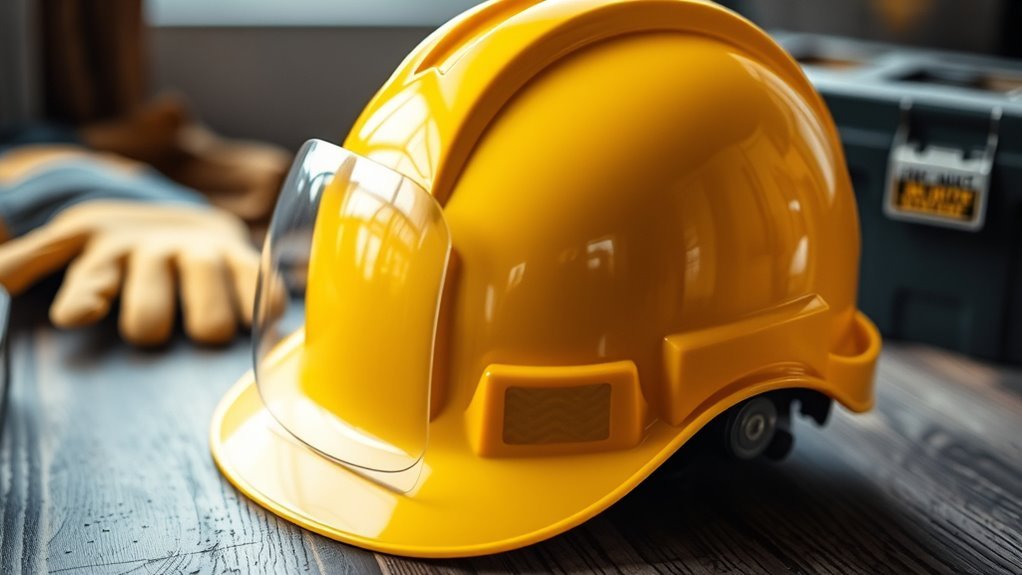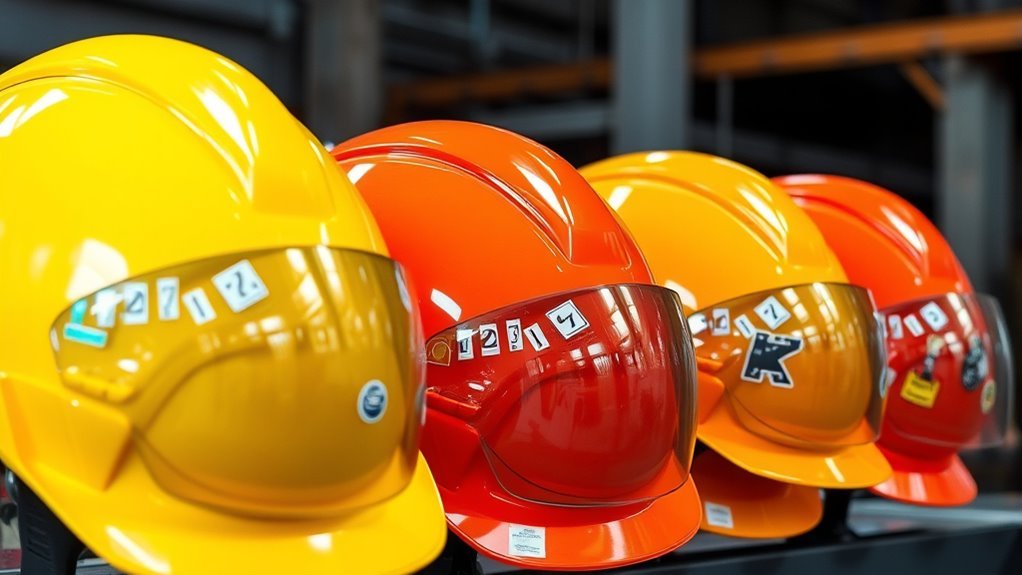Electrical Safety Helmets – What You Need to Know
Electrical safety helmets are vital for protecting you from hazards like arc flash and electrical shock. They must meet industry standards for impact resistance and electrical insulation. A proper fit enhances comfort and prevents accidents during use. It’s important to regularly inspect your helmet for damage and maintain it to guarantee maximum protection. Following best practices and training on safety will further enhance your awareness. Discover more about selecting the right helmet and securing your safety at work.
Understanding Electrical Hazards

Understanding electrical hazards is essential for anyone working in environments where electricity is present, as these hazards can lead to severe injuries or fatalities. Two major risks you face are arc flash and electrical shock. An arc flash occurs when electrical current passes through the air between ungrounded conductors or a conductor and ground, causing a rapid release of energy. This can result in intense heat and pressure, potentially leading to burns or other serious injuries. Electrical shock, on the other hand, happens when current flows through your body, which can disrupt your heart rhythm and cause severe injuries or death. Recognizing these hazards and implementing proper safety measures is vital for maintaining a safe work environment. Stay informed and protected.
Key Features of Electrical Safety Helmets

Electrical safety helmets play an essential role in protecting workers from the dangers associated with electrical hazards like arc flash and electrical shock. One key feature is impact resistance; these helmets are designed to withstand significant force, guaranteeing your head is protected from falling objects. Additionally, effective electrical insulation is vital, as it prevents electrical currents from passing through the helmet, providing a barrier between you and any live wires or equipment. Look for helmets that meet industry specifications for both impact resistance and electrical insulation to guarantee maximum safety. Lightweight designs and adjustable fittings also enhance comfort and usability, allowing you to focus on your tasks without compromising safety. Remember, choosing the right helmet can make a significant difference in your protection.
Industry Standards and Certifications

When selecting electrical safety helmets, it’s essential to understand the key certification standards that guarantee compliance with regulations. These standards not only outline the necessary safety features but also detail the testing and quality assurance processes that helmets undergo. By familiarizing yourself with these certifications, you can make informed decisions to enhance your safety on the job.
Key Certification Standards
Certification standards play an essential role in guaranteeing the safety and reliability of electrical safety helmets. These standards are established through rigorous certification processes that evaluate materials, construction, and performance under various conditions. Key organizations like ANSI and IEC set benchmarks for electrical resistance, impact protection, and durability.
When selecting a helmet, look for products that have undergone thorough safety assessments to confirm compliance with these standards. This includes testing for dielectric properties to prevent electric shock and guaranteeing that the helmet can withstand impacts. By choosing certified helmets, you’re making a conscious decision to protect yourself while enjoying the freedom to work safely in electrical environments. Always prioritize helmets that meet or exceed industry standards to guarantee maximum protection.
Compliance With Regulations
Guaranteeing compliance with industry regulations is essential for the effective use of electrical safety helmets. You need to stay updated on regulatory updates that could impact helmet specifications and performance standards. Various organizations, such as ANSI and IEC, set these standards, and your helmets must meet them to guarantee safety. Regular compliance audits will help you verify that your helmets are in line with current regulations. This proactive approach not only protects your workforce but also minimizes legal risks. Remember, non-compliance can lead to serious consequences, including accidents and penalties. By prioritizing adherence to these standards, you empower your team with the freedom to work confidently, knowing they’re protected by certified safety gear.
Testing and Quality Assurance
While compliance with industry standards is essential, the testing and quality assurance of electrical safety helmets play an important role in guaranteeing their reliability and effectiveness. Various testing methods, including electrical resistance tests and impact assessments, are employed to evaluate helmet performance under real-world conditions. These methods help identify any weaknesses that could compromise safety. Quality checks are implemented throughout the manufacturing process to ascertain that each helmet meets the specified standards. This includes material inspections, assembly evaluations, and final product testing. By adhering to rigorous testing protocols and quality assurance measures, manufacturers can provide you with helmets that not only meet regulatory requirements but also deliver the protection you need in hazardous environments.
Importance of Proper Fit and Comfort
A well-fitted electrical safety helmet is essential for effective protection in hazardous environments. If your helmet doesn’t fit properly, it can compromise your safety by shifting or falling off during critical moments. Make sure to utilize fit adjustments to achieve a snug yet comfortable fit that won’t inhibit your movements. Comfort features, such as padded liners and adjustable straps, enhance wearability, allowing you to focus on your tasks rather than constant adjustments. A helmet that feels good encourages you to wear it consistently, which is key to maintaining safety standards. Remember, the right fit and comfort are not just about convenience; they’re crucial for ensuring your protection against electrical hazards. Prioritize these aspects for peak safety and performance.
Maintenance and Care for Safety Helmets
To maintain the effectiveness of your electrical safety helmet, regular care and inspection are essential. You should establish consistent inspection intervals, ideally every month, to check for cracks, dents, or any signs of wear. If you notice any damage, replace the helmet immediately. For cleaning, use mild soap and warm water, avoiding harsh chemicals that could degrade the materials. Employ gentle cleaning techniques, like soft cloths or sponges, to prevent surface scratches. After cleaning, verify the helmet is completely dry before storage. Store it in a cool, dry place, away from direct sunlight and extreme temperatures. By following these practices, you can extend the life of your helmet and guarantee peak safety during electrical work.
Selecting the Right Electrical Safety Helmet
When selecting the right electrical safety helmet, you need to take into account the material’s durability and insulation properties to guarantee ideal protection. It’s also essential that the helmet complies with relevant certification and safety standards to assure its effectiveness in hazardous environments. Making informed choices in these areas can greatly enhance your safety on the job.
Helmet Material Considerations
Selecting the right electrical safety helmet hinges considerably on the materials used in its construction. You’ll want to take into account factors like helmet durability and helmet weight to guarantee you’re making the best choice for your needs. Here are some key material considerations:
- Polycarbonate: Known for its high impact resistance and lightweight properties.
- Fiberglass: Offers excellent electrical insulation and durability.
- HDPE (High-Density Polyethylene): Provides a balance of strength and lightweight feel.
- ABS (Acrylonitrile Butadiene Styrene): A cost-effective option with decent durability.
- Foam Lining: Enhances comfort and impact absorption, vital for long-term wear.
Certification and Standards Compliance
Understanding the materials used in electrical safety helmets is only part of the equation; compliance with certification and industry standards is equally important. To guarantee your safety helmet meets necessary requirements, familiarize yourself with the certification processes and compliance verification.
| Standard | Description | Importance |
|---|---|---|
| ANSI/ISEA 121 | Ensures adequate protection | Protects against falling objects |
| ASTM F1506 | Tests for electrical hazards | Reduces risk of electric shock |
| CSA Z94.1 | Covers general safety standards | Ensures overall helmet reliability |
Selecting a helmet that adheres to these standards not only enhances safety but also grants you the freedom to work confidently in hazardous environments.
Best Practices for Wearing Electrical Safety Helmets
Though wearing an electrical safety helmet may seem straightforward, adhering to best practices is essential for guaranteeing maximum protection against electrical hazards. Follow these helmet usage guidelines for peak safety:
- Verify the helmet fits snugly and comfortably, without obstructing vision.
- Inspect the helmet regularly for damage, including cracks or wear.
- Avoid modifying the helmet with unauthorized attachments.
- Keep the helmet clean and free from debris that could compromise its integrity.
- Replace the helmet after an electrical incident or every five years, whichever comes first.
Training and Awareness for Workers
Proper helmet usage is just one aspect of ensuring safety in environments where electrical hazards exist. To truly protect yourself and your colleagues, thorough worker education is essential. Familiarize yourself with the specific safety protocols relevant to your work environment. Regular training sessions should cover the proper use of electrical safety helmets, identifying hazards, and emergency response procedures. Understanding the risks associated with electrical work empowers you to make informed decisions. Additionally, staying updated on safety advancements and regulations can enhance your knowledge base. Remember, it’s not just about wearing a helmet; it’s about cultivating a culture of safety. By prioritizing training and awareness, you foster an environment where everyone can work confidently and safely, embracing the freedom that comes with being well-informed.
Frequently Asked Questions
Can I Wear Glasses With an Electrical Safety Helmet?
You can wear glasses with an electrical safety helmet, but it’s essential to guarantee compatibility. Just as a key fits a lock, your helmet needs to adjust properly to accommodate your glasses. Look for helmets designed with extra space or features that allow for adjustments. This way, you won’t sacrifice safety for comfort. Always check the fit to guarantee nothing obstructs your vision, letting you work freely and safely.
How Often Should I Replace My Electrical Safety Helmet?
You should replace your electrical safety helmet every 3 to 5 years, depending on the manufacturer’s guidelines and the helmet’s condition. Regular helmet maintenance is essential; inspect it for cracks, dents, or signs of wear after each use. If you notice any damage, replace it immediately. Remember, your safety’s paramount, so don’t compromise on the integrity of your helmet. Staying proactive about replacement frequency helps guarantee maximum protection while you work.
Are There Specific Colors for Electrical Safety Helmets?
Ever wondered how a helmet’s color can impact your safety on the job? Yes, there are specific colors for electrical safety helmets that align with safety color codes. These colors enhance visibility, making it easier for others to spot you in hazardous environments. For instance, bright colors like yellow or orange are often used to signify caution, while white might indicate a supervisor. Choosing the right color can greatly contribute to your overall safety and awareness.
Can Electrical Safety Helmets Be Customized With Logos?
Yes, electrical safety helmets can be customized with logos, offering various customization options. You can choose different placements for your logo, whether it’s on the front, sides, or back of the helmet. This not only enhances brand visibility but also allows for a personalized touch in your safety gear. Just make certain that any customization doesn’t interfere with the helmet’s safety standards or functionality, keeping you protected while promoting your brand effectively.
What Is the Lifespan of an Electrical Safety Helmet?
An electrical safety helmet typically lasts around 3 to 5 years, depending on the helmet material and exposure conditions. You might think that as long as it looks fine, it’s still usable, but that’s not the case. Helmets need to meet safety standards, and factors like UV exposure and wear can degrade their effectiveness over time. Regular inspections can help guarantee you’re protected and compliant with safety regulations.






